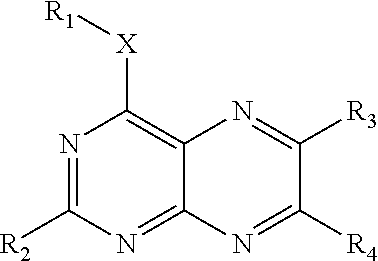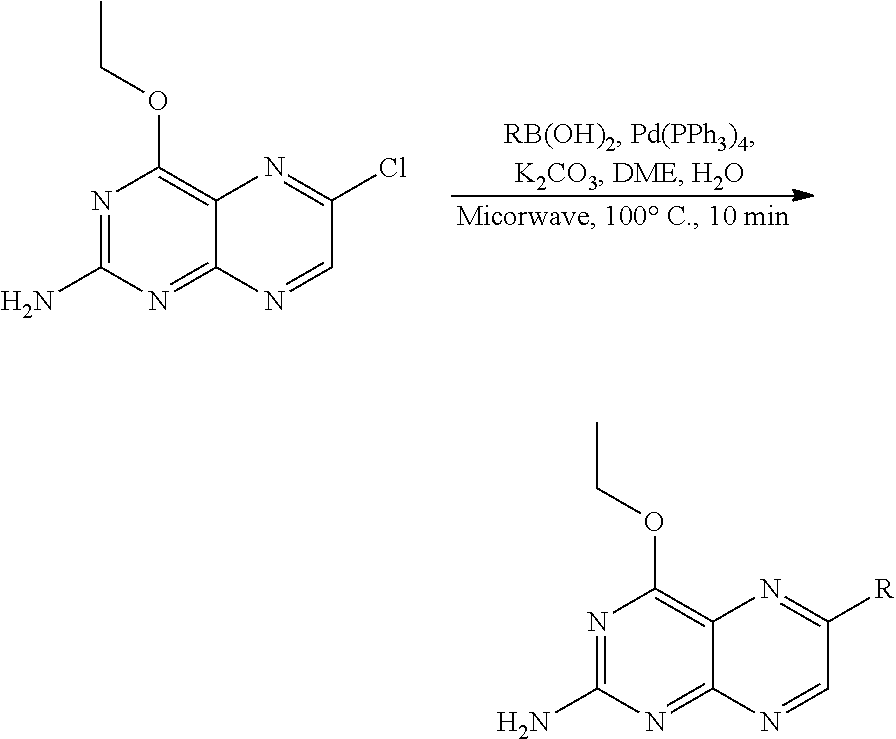Substituted pteridines useful for the treatment and prevention of viral infections
a technology of pteridine and substituted pteridine, which is applied in the field of substituted pteridines, can solve the problems of inability to integrate hcv into the host's genome, inability to eradicate infection in most people, and inability to carry cirrhosis and/or liver cancer, etc., and achieves significant and selective activity, inhibiting the replication of hepatitis c virus
- Summary
- Abstract
- Description
- Claims
- Application Information
AI Technical Summary
Benefits of technology
Problems solved by technology
Method used
Image
Examples
examples 1 to 73
mino-4-ethoxy-6-substituted Pteridines
[0302]The synthetic method may be represented schematically as follows:
[0303]
[0304]The general procedure used for preparing 2-amino-6-aryl-4-ethoxy-pteridines and 2-amino-6-heteroaryl-4-ethoxy-pteridines starts from the common intermediate 2-amino-6-chloro-4-ethoxypteridine (described in WO 2005 / 025574) as follows. A mixture of 2-amino-6-chloro-4-ethoxypteridine (23 mg, 0.1 mmol), potassium carbonate (27 mg, 0.2 mmol), tetrakis(triphenylphosphine) palladium (8 mg, 0.007 mmol) and a suitable arylboronic or heteroarylboronic acid, or a pinacol ester thereof, (0.12 mmol) in dimethylether (1.5 mL) and water (1 mL) was heated to 100° C. for 10 minutes under microwave irradiation. Solvents were concentrated in vacuo and the residue was purified by high performance liquid chromatography (hereinafter referred as HPLC) onto a C18 column with a gradient of H2O, 0.1% TFA-acetonitrile, in order to afford the pure desired product. This procedure provided, wi...
examples 74 to 140
no-4-morpholin-4-yl-6-substituted-pteridines
[0307]The scheme below shows a general procedure for the synthesis of 2-amino-4-morpholin-4-yl-6-substituted-pteridines.
[0308]
Synthesis of 4-morpholin-4-yl-pteridin-2-ylamine (Example 74)
[0309]To a solution of 2,5,6-triamino-4-morpholino-pyrimidine dihydrochloride (7.08 g, 25 mmol) in ethanol (60 mL) was added glyoxal (405 solution in water, 2.9 mL, 25 mmol). The reaction mixture was refluxed for one hour. After cooling, the solvent was removed under reduced pressure. The residue was purified by flash chromatography (using 7% MeOH / DCM as the eluent), providing the pure title compound in 80% yield (4.6 g), which was characterized by mass spectrometry as follows: MS (m / z) 233.3 [M+H]+.
Synthesis of 4-morpholin-4-yl-8-oxy-pteridin-2-ylamine (Example 75)
[0310]To a cooled (0° C.) solution of 4-morpholin-4-yl-pteridin-2-ylamine (4.6 g, 20 mmol) in trifluoroacetic acid (80 mL) was added dropwise 5.1 mL of a 35% aqueous H2O2 solution. The reaction ...
example 141
f N-[6-(4-Amino-phenyl)-4-morpholin-4-yl-pteridin-2-yl]-acetamide
[0315]Synthesis proceeds according to the following scheme:
[0316]
[0317]A mixture of 2-amino-6-chloro-4-morpholino-pteridine (600 mg, 1.9 mmol), potassium carbonate (394 mg, 66 mmol), tetrakis(triphenylphosphine) palladium (66 mg, 0.057 mmol) and 4-(4,4,5,5-tetramethyl-[1,3,2]dioxaborolan-2-yl)-phenylamine (511 mg, 2.3 mmol) in dimethylether (6 mL) and water (3 mL) was heated to 110° C. for 4 minutes under microwave irradiation. Solvents were concentrated in vacuo and the resulting solid was washed with water, methanol, and dichloromethane to provide 502 mg (yield: 72%) of the desired product as an orange solid, which was characterized by its mass spectrum as follows: MS (m / z) 366.8 [M+H]+.
PUM
| Property | Measurement | Unit |
|---|---|---|
| optical purity | aaaaa | aaaaa |
| optical purity | aaaaa | aaaaa |
| optical purity | aaaaa | aaaaa |
Abstract
Description
Claims
Application Information
 Login to View More
Login to View More - R&D
- Intellectual Property
- Life Sciences
- Materials
- Tech Scout
- Unparalleled Data Quality
- Higher Quality Content
- 60% Fewer Hallucinations
Browse by: Latest US Patents, China's latest patents, Technical Efficacy Thesaurus, Application Domain, Technology Topic, Popular Technical Reports.
© 2025 PatSnap. All rights reserved.Legal|Privacy policy|Modern Slavery Act Transparency Statement|Sitemap|About US| Contact US: help@patsnap.com



